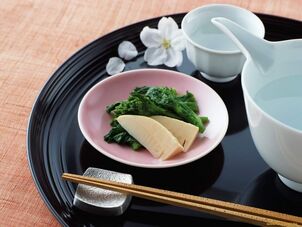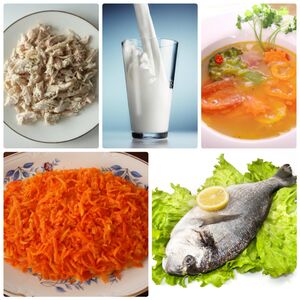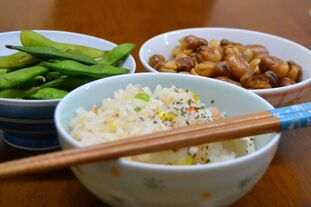
Increasingly, new ways of losing weight are becoming more popular among people looking to lose weight. This article will look at the Japanese diet in detail, nature, rules, menus, reviews and more.
The Essence of the Diet
The Japanese diet is one of the most popular weight loss methods today. The essence of this activity is that low-calorie foods, i. e. proteins, fats and carbohydrates get into the body in insufficient quantities, which is why rapid weight loss. To get the most out of this way of losing weight, you should strictly adhere to the menu.
The benefits of this weight loss approach include:
- Able to lose a lot of weight in a fairly short time.
- The diet included a variety of foods that could be processed, as opposed to the single hard diet (rice, buckwheat).
- Thanks to the correct restructuring of the body's metabolism and the correct exit from the diet, the lost weight will not return.
- Since the menu is rich in vegetables, juice and fruit, the intestines are cleared of toxins, and the work of the stomach is improved.
- Green tea included in the diet improves mood, adds strength and acts as an antioxidant.
- It is allowed to cook food in a variety of ways - boiled, baked and even fried, so it's not too hard to follow.
- Taste preferences change, health improves and overall performance increases.
- There are no complicated menus so you do not need any special knowledge of cooking.
Cons include:
- Drinking coffee regularly can lead to bloating and heartburn.
- If the output is incorrect, the lost weight can be quickly returned.
- Such a diet can aggravate a number of diseases and worsen health.
- Lack of carbohydrates and vitamins can cause the body to be depleted.
The rules of the diet
Prohibited foods include:
- Alcohol.
- Fatty meat.
- Sugar and sweets.
- Powder products.
- Pasta.
- Salt.
- Smoked foods.
- Powder products.
- Potatoes.
- Salo.
- Mayonnaise and other sauces.

Recommended foods:
- Eggs.
- Poultry and fish.
- Vegetables and fruits.
- Seafood.
- Cheese and cheese.
- Coffee and green tea.
- Green.
- Rye biscuits.
- Homemade vegetable and fruit juices.
In addition, this weight loss system assumes compliance with the following nutritional rules:
- The menu should be strictly adhered to and the order of dates should not be changed.
- Do not add other foods to your diet.
- Drink at least 1. 5 liters of green tea per day without sugar or water.
- This food can be consumed no more than once a year.
- Meat and fish can be steamed, boiled or grilled with a little oil.
- Complex vitamins should be included in the diet.
- Coffee must be made naturally, not from powder.
- Vegetables and fruits can be eaten whole or as a salad.
- Salad can be impregnated with olive oil.
Types
There are three types of these diets, each with its own characteristics:
- Diet for seven days.Its features are as follows:
- Completely removes salt.
- Eat only marine fish, vegetables, juice, eggs, and meat. During this time, you can lose up to 7 kg.
- Thirteen days of weight lossoffers the following nutritional features:
- Seafood added to the diet.
- The rest of the menu remains unchanged. This type of technique plays a more psychological role, as it lasts a day less than a two-week diet and one day can mean a lot for a person to lose weight.
- Fourteen days of weight lossis twice as much as a seven-day diet this way. It is used when a person wishes to continue to lose weight and has the desire and power for this. In terms of nutrition, reality remains unchanged, except that the menu can be expanded with new vegetables or fruits.
Menu
The menu for this fourteen days is as follows:
1. First week

- Monday:
- Breakfast - coffee.
- Lunch - two boiled eggs, tomato salad.
- Dinner - boiled beef, apple juice.
- Tuesday:
- Breakfast - coffee, oatmeal.
- Lunch - stewed vegetables, steamed fish.
- Dinner - cheese, orange juice.
- Wednesday:
- Breakfast - coffee.
- Lunch - broccoli and tomatoes, steamed chicken.
- Dinner - apple, grapefruit.
- Thursday:
- Breakfast - green tea.
- Lunch - two boiled eggs, stewed zucchini.
- Dinner - stewed beef, tomatoes.
- Friday:
- Breakfast - boiled eggs, coffee.
- Lunch - steamed fish, carrot juice.
- Dinner - seafood, apples.
- Saturday:
- Breakfast - green tea.
- Lunch - stewed beef with vegetables, tea.
- Dinner - kefir.
- Sunday:
- Breakfast - coffee.
- Lunch - carrot and turnip salad, boiled fish.
- Dinner - kefir, apples.
2. Week 2
- Monday:
- Breakfast - a boiled egg, coffee.
- Lunch - hard sur, apple.
- Dinner - fried fish, stewed vegetables.
- Tuesday:
- Breakfast - tea.
- Lunch - grilled eggplant, fish ball, tea.
- Dinner - boiled chicken fillet, cabbage salad.
- Wednesday:
- Breakfast - coffee.
- Lunch - roasted turkey, stewed zucchini.
- Dinner - apples, oranges.
- Thursday:
- Breakfast - tea.
- Lunch - boiled beef, cucumber and tomato salad.
- Dinner - pear, pineapple.
- Friday:
- Breakfast - coffee, diet cookies.
- Lunch - fruit.
- Dinner - Broccoli salad with herbs, grilled fish.
- Saturday:
- Breakfast - coffee.
- Lunch - two boiled eggs, tomato.
- Dinner - grilled fish, tomatoes.
- Sunday:
- Breakfast - tea.
- Lunch - boiled beetroot salad, carrot juice.
- Dinner - kefir, boiled chicken.

Eliminating the diet
In order for the lost weight to not return, you need to get out of the diet correctly.
To do this, follow these rules:
- After finishing the diet, do not overeat, eat it regularly, dividing it into small portions.
- The best breakfast is porridge.
- During the first week after completing your diet, you should also eat boiled meats and vegetables regularly. Even in the future, it is advisable to adhere to a similar diet.
- Sweets should be limited.
- Salty foods should also be eaten very carefully and in small amounts.

Reviews of people who are losing weight
To better understand the effects this diet has on, take a look at the reviews of people who have tried it themselves:
- Review # 1. “I've been on this diet 4 times already, and I've lost 5 kg each time. I want to say that the menu in it is simple, all the products are natural and healthy (except for coffee). Also should drink smoothies with meals like that. Otherwise, the hair will become duller very quickly and nails become brittle due to their lack of them.
- Review # 2. “The first time I tried the Japanese weight loss system I was surprised, because with its help in just one week, I lost seven and a half pounds! After that, I decided to extend the course and in seven days I have lost five kilograms. For me, it was a success. Now about the downside: I want to eat all the time, and after such a diet, my metabolism has gone awry. "
- Rating # 3. “One week ago, I completed a weight loss course designed for fourteen days. My result during this period was minus six kilograms. The most difficult for me was the early days of such a diet, and the complete refusal of salt and sweets. All the food seemed bland and tasteless, but then I really started to better distinguish the taste of each product and I even liked it. To taste the salt, I poured lemonade into the salad, and it helped me. Also, the menu also includes meat and fish so I'm not very hungry. So far, no kilogram has returned so I'm so happy! "
- Review No. 4. “I have been following the Japanese diet for a week and am very disappointed that I only lost two kilograms out of six pounds I promised. In addition, this diet is not balanced and is not enough for the normal functioning of the body. Also, I don't think drinking coffee every day on an empty stomach won't hurt the stomach. For me personally, this is a very suspicious technique, so I don't think I will repeat it. "
- Review No. 5. “I tried many different diets, and the last one was the Japanese one. I sat on it for two weeks and even followed all the nutritional rules. At first it was unusual to eat everything without salt, since I enjoyed eating salty, but beauty was more important to me. Gradually, I got used to and didn't even notice that the food was not too salty. In terms of menu, it's quite delicious, as it has fruits, vegetables, fish and more. The only drawback I have noticed in such a diet is vitamin loss and lack of glucose, which sometimes makes me dizzy. In general, I have already lost six kilograms during this time, and that's enough for me. "
After analyzing the reviews, we can say that in most cases the Japanese diet is effective and helps with weight loss. However, due to a disproportionate diet, lack of spices, sugar and salt, maintaining such a diet is difficult.
Doctors' opinion
Nutritionists argue that, despite the positive reviews, the Japanese diet, like any restrictive nutritional system, disturbs metabolism and leads tostress in the body. Also, doctors recommend giving up the daily use of coffee for breakfast, as this leads to heart and stomach problems.
People who already have health problems should be especially careful when following this method of weight loss, as such a diet can worsen a person's condition. Also, nutritionists do not recommend repeating the Japanese-style diet more than once per year, otherwise you could seriously cut off your diet, which just doesaggravating weight loss process.
However, if a person is healthy and does not have the special contraindications described below, then that person can adhere to this regime. The main thing is to follow the rules of the diet and not lose portions in the hope that this will speed up the weight loss process. If, during the dieting process, you feel unwell, your mood worsens or you lose your health, you should stop this technique and switch to a regular, balanced diet.
Contraindicated for use
- Pregnancy and lactation.
- Under the age of eighteen.
- Heart, liver and kidney diseases.
- Diseases of the digestive organs, their exacerbations.
- Chronic diseases.
- Gastritis.
- Hypertension.
- Diabetes.
Flash tip
- You should consult a registered dietitian before starting this diet.
- It is impossible to follow this diet for more than two weeks, otherwise metabolism could be seriously disturbed.
- If dizziness or stomach pain occurs during this meal, stop the diet immediately.

































